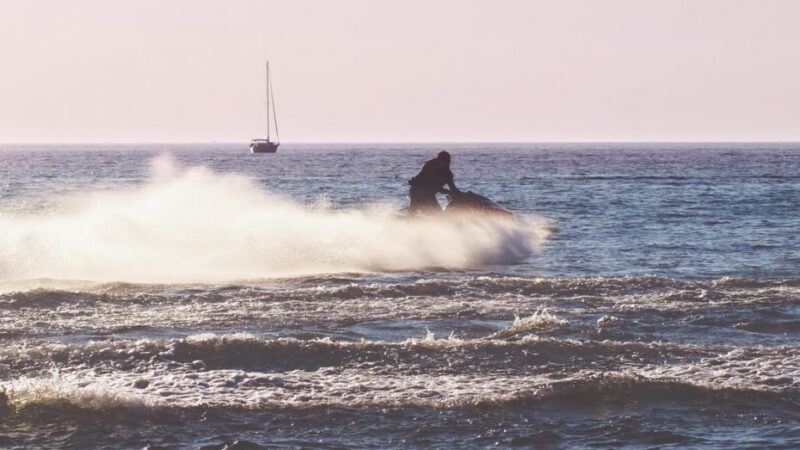Humans have long enjoyed a nice, cool bevvy. Centuries before chilled chardonnay, wealthy Romans would lower the temperature of their wine with snow that slaves had carted from nearby mountains.
During the 19th century, the ice trade was big business, involving the mass harvesting, storage and export of ice from cool climates such as Norway and the east coast of the United States all across the world.
Refrigeration using ice boxes allowed people to keep perishable food in their homes for the first time. Before then, most food was stored using preservation methods such as salting, pickling and drying. In Australia, the Coolgardie safe was one early answer to the need for cooling, a set-up involving hessian, a tray of water and the powers of evaporative cooling.
But keeping things fresh away from home was always a challenge. Nowadays, we use ice bricks or buy bags of cubed or block ice from service stations and supermarkets to fill up coolers for a day of fun at the beach or park.

The classic Esky.
In Australia, these are called Eskies.
Like few other products, the Esky has come to symbolise Australian summer. It’s an invention we take for granted as we reach into the plastic tub to pluck a cold drink from the sea of icy water on a sunny day.
So where did they come from and how do they work? Are they a relic from another time or have they evolved?
Why are they called Eskies?
Esky is actually a brand name, short for eskimo. It’s a term for people who live in and around the Arctic that is now considered by many to be offensive, although it is still used in places such as Alaska.
The name was registered by Australian whitegoods company Malleys in 1961 and was so popular that it became what’s known as a generic trademark. That’s when a brand name enters the local vernacular, such as Glad Wrap for cling film or Hills Hoist for clothes line.
It’s a word specific to Australia; New Zealanders say “chilly bin” and Americans use “cooler”.
Early Esky slogans included “Take the party with you” and “Cool, man, cool”.

Comedian Garry McDonald as satirical character Norman Gunston in 1980.Credit:The Age
Where did they come from?
Before electric refrigerators were common in the home, people used chests that held blocks of ice to cool food. The inevitable evolution was a portable version, first sold in Australia in 1952.
Advertisements for the Esky Auto Ice Box trumpeted its “lustrous green baked enamel and chrome”. Intended for use in cars, the galvanised iron boxes had cork insulation to keep things cool while travelling. By the end of the 1950s, it was claimed that “500,000 happy picnickers” were using Eskies.

An early Esky advertisement.Credit:
“When you look at where Australia was in the 1930s and the rationing of the 1940s, the 1950s saw optimism and growth,” says Anni Turnbull, assistant curator at the Museum of Applied Arts and Sciences in Sydney, where an early Esky is part of the collection.
“Cars transformed the way of life, expanding leisure activities. The initial use of the Esky was about going to picnics and camping.”

Sydney Cricket Ground, 1975.Credit:Quentin Jones
What were they used for?
It wasn’t long before Australians were using Eskies to cart around tinnies and stubbies. “It didn’t start off associated with beer,” says Turnbull. “It grew into that in the 1970s and 1980s.”
Australia reached “peak beer” in the mid 1970s, when annual consumption of alcohol was the equivalent of more than 500 stubbies per person per year. Drinking habits are now less than half that, as wine rivals the once dominant amber fluid as our favourite tipple and the health effects of booze come under increasing scrutiny.
Back in the ’70s, though, the lager-swilling Australian was a feature of pop culture with characters such as Barry McKenzie revelling in downing (and regurgitating) Foster’s on the big screen in The Adventures of Barry McKenzie. Super Dag, a character from the hit The Paul Hogan Show, carried an Esky that had special powers.
Above: Comedian Paul Hogan as Super Dag, with a magic Esky.
A heavy drinking culture led to the Esky becoming a popular 21st birthday gift, particularly with men. And, back in the days when BYO was permitted at sporting events, it was a common sight to see people lining up with beer-packed Eskies. These days, BYO alcohol is banned at venues such as the Sydney and Melbourne cricket grounds, and large items that won’t fit under a chair are not allowed in.
Back in 1980, the unruly behaviour of cricket fans after consuming the contents of their Eskies prompted a Malleys sales rep to defend the brand. “If you buy a shotgun and shoot yourself you don’t blame the manufacturer … the Esky was certainly not designed to disrupt the cricket,” he told The Age.

Cricketer Doug Walters eats a pie and sits on an Esky near the Hill at the SCG in 1981 to promote a book, The Doug Walters Story.Credit:The Sydney Morning Herald
Meanwhile, a spokesman for rival brand Willow was philosophical about the word Esky becoming part of the language. “We can’t lose sleep over it,” he said. “It would take a massive marketing job to change that, which would cost us a fortune.”
In 2000, Eskies featured in the closing ceremony at the Sydney Olympics as part of a souvenir kit for those who attended.

Eskies held aloft at the 2000 Olympics closing ceremony. Credit: Vince Caligiuri
The Esky brand was sold to manufacturer Nylex in 1984, which began constructing the coolers entirely out of plastic. Plastic was already being used for the lids and liners of Eskies, in addition to steel. US company Coleman had introduced the then wonder material in 1957, helping it to popularise the cooler in the United States after the first patent was filed in 1951. It would go on to buy the Esky name in 2009 and still sells it today.
Lighter, easier to clean and, most importantly, better at keeping things cool than metal, plastic was a game changer for the portable cooler and is still what they are made out of today.

It’s Esky first into the Noble Stand at the SCG, 1983.Credit:Paul Matthew
It took some time for the innovation to make it to Australia, with the all-steel variety rusting away in garages around the country until the 1970s. Eskies were soon made out of the likes of polyethylene and polypropylene, with styrofoam and later polyurethane used as insulation.
Many people are now trying to cut down on using plastic, especially single-use; but rather than ending up at the tip, Eskies seem to be one of those items that linger in households for years.
Plastic has other benefits, such as buoyancy. Eskies have featured in several survival stories, where people have used them to stay afloat in the sea. In one example, two Burmese fishermen survived almost a month floating in a large Esky after their small wooden boat sank in the Torres Strait.
How do coolers work?
Heat is transferred in three ways: convection, conduction and radiation. When you touch something that feels cold, that’s the energy of the heat leaving your fingers. With Eskies, it’s about keeping the heat out rather than the cool in.
Lucky, as science communicator Dr Karl Kruszelnicki says, “you’ve got yourself a damned good insulator”.
The reason why Eskies have insulation is mainly to prevent conduction, which is heat spreading between objects that are touching. The inner and outer shells, along with the foam on the inside, have low thermal conductivity, meaning the heat moves through slowly, a bit like double-glazed windows.
An advertisement shows Solo Man “wakeboarding” on an Esky lid.
Dr Karl uses the analogy of getting out of bed in winter and putting your feet on the floor. “You step out of bed and on to the carpet, which is at a temperature of four degrees centigrade, but the carpet has very low thermal conductivity so your feet don’t feel cold,” he says.
“And you take a few steps to the bathroom to have a wee and there are tiles. They’re at the same temperature as the carpet but because they’ve got a high conductivity, the heat goes through quickly.”
The thicker the material, the better with insulation because the heat will take longer to get through. The gas bubbles inside foam help lower conduction too.
Convection involves heat transferring through air currents. Keeping an Esky lid shut obviously helps with that, as does a good rubber seal. This is also the reason why a more tightly packed Esky will perform better, as there is less room for air inside to warm things up.
Should you drain the water in an Esky?
This is a controversial debate and many people will swear black and blue that draining the water from an Esky is the way to go. But Dr Karl Kruszelnicki says you should always hold off on doing this as long as you can.
“As long as it is cooler than the outside air temperature, you should keep the water with the beer or the holy water or whatever’s inside,” he says.
When ice cools things down, it is absorbing the thermal energy of the heat that would otherwise warm up the beer. As ice melts into water, it remains at the same temperature until it is all gone. Once that happens, the water heats up rapidly.
The type of ice also has an impact too. Cubed ice melts faster but chills things quicker. Block ice, due to having less surface area, lasts longer.

Friends get together in Melbourne in December (and demonstrate another function of Eskies – as seats).Credit:Eddie Jim
Are Eskies still a thing?
“Rotomoulding” is the latest innovation when it comes to coolers. It’s a construction process that creates a cooler out of one continuous piece of plastic by heating it up and putting it into a mould before spinning it around.
The companies that use rotomoulding say this improves performance as it ensures that the plastic is the same thickness and has less imperfections for heat to get in.
It’s also makes things more expensive. Yeti, a cult brand in the United States that uses rotomoulding, sells its coolers for hundreds of dollars more than standard varieties. They say they hold ice for much longer, using stronger buckles to help lock out the heat. This is an example of how it is marketed:
It’s all a long way from the first iron boxes in the 1950s. New sizes and shapes, even soft cooler bags, have come along. Extra features such as sets of wheels have made Eskies easier to use.

The Dearn family chill out with croissants and bubbles on Christmas Day in North Fitzroy, Melbourne.Credit:Felicity Lewis
The basic idea still holds true, however: people want a place to keep things cool. It’s what they put inside their Eskies that has probably changed the most. Mass-produced lager and Anglo food have given way to a variety of cuisines. It might still hold a slab of beer on a camping trip but an Esky is now just as likely to be used to cool an antipasto platter or a bottle of prosecco.

Cool cats: a Christmas family picnic in North Fitzroy, Melbourne.Credit:Felicity Lewis
In some ways, the Esky has come full circle, back to the picnics it was taken to when first invented – just check out your local park on a warm evening, or a sunny day.
“They’re pretty remarkable, aren’t they?,” says Turnbull. “They’re still part of our icons of Australian leisure and summer.”

The Kalithrakas and Sveronis families picnic with their cooler at Centennial Park in Sydney in December.Credit:Cole Bennetts
Let us explain
If you’d like some expert background on an issue or a news event, drop us a line at explainers@smh.com.au or explainers@theage.com.au. Read more explainers here.





Recent Comments